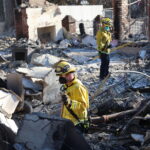About the photo: A woman takes a selfie in front of Cloud Gate, known as the Bean, during a snow storm in Chicago on Feb. 9, 2018. Photographer: Christopher Dilts/Bloomberg
A potentially record-breaking storm is squeezing the warmth from spring as it brings snow and howling winds across the U.S. Great Plains and threatens to flood rivers from Canada to the Gulf of Mexico.
The giant system, set to strengthen Wednesday, has sparked blizzard warnings from Colorado to Minnesota and could drop more than two feet (60 centimeters) of snow in South Dakota and as much as 8 inches in Minneapolis, the National Weather Service said. Severe thunderstorms will hit Texas and the Mississippi Valley. The system threatens to delay wheat and corn planting.
“It is pretty extensive,” David Roth, a senior branch forecaster at the U.S. Weather Prediction Center, said by telephone.
The storm, which will pack near-record low pressure, could be on par with the massive system that triggered flooding across Nebraska and Iowa last month. Snow and rain area already falling across the Great Plains and Midwest. The storm will build over Wyoming Wednesday, cross Nebraska Thursday and then hit Minneapolis, said Rob Carolan, owner of Hometown Forecast Services.
Farther south, the storm will push dry winds across Kansas, Oklahoma, New Mexico and Texas — raising risk for wildfires.
Flood Risk
The Mississippi River is already at moderate-to-major flood stage in Wisconsin, Illinois and Iowa. The Red River is at major flood stage in Fargo, North Dakota.
“Because the Mississippi is flooding — none of this is welcome,” Roth said.
Nonetheless, the Mississippi should be able to handle this week’s storm, because water levels are currently falling, said Matt Roe, spokesman for the Army Corps of Engineers in New Orleans. The Corps has begun to close the Bonnet Carre spillway upstream from New Orleans, designed to prevent flooding.
High water has restricted Mississippi barge traffic to daylight and has limited the amount of freight that can be hauled, said Austin Golding, president of Golding Barge Line in Vicksburg, Mississippi. Right now, the river is entirely navigable, but the hardest parts to traverse are the bridges in Vicksburg and Baton Rouge.
“May will be nasty if it gets hot up north and the snow melt accelerates after this winter system they are encountering now,” Golding said.
Weather Whiplash
This system’s icy reach won’t extend to Chicago, which will get rain and have a low of 39 Fahrenheit (4 Celsius) Wednesday before temperatures rebound into the 60s by Thursday. Detroit and Toronto will also be spared, Carolan said.
As the storm passes, weather will whiplash between extremes in many places. On Tuesday, Denver’s temperature reached 78 degrees. Wednesday, however, the city is under a blizzard warning with readings set to plunge to 21, the weather service said. Cheyenne, Wyoming, will go from 71 on Tuesday to 18 degrees late Wednesday.
While the storm bulldozes its way across the central U.S., mild air on the East Coast will keep temperatures in New York in the high 50s and low 60s through the rest of the week, the weather service said.
The snow and rain across the northern Midwest will delay corn and wheat planting, said Dan Hicks, a meteorologist with Freese-Notis Weather Services in Des Moines, Iowa. Farther south, from Kansas to Southern Illinois, planting is unlikely to be interrupted.
Was this article valuable?
Here are more articles you may enjoy.

 Supreme Court Refuses to Revive Youths’ Climate-Change Lawsuit
Supreme Court Refuses to Revive Youths’ Climate-Change Lawsuit  Teen’s Suicide Turns Mother Against Google, AI Chatbot Startup
Teen’s Suicide Turns Mother Against Google, AI Chatbot Startup  After the Flames: Preparing for the Growing Fraud Threat in Los Angeles
After the Flames: Preparing for the Growing Fraud Threat in Los Angeles  California Insurance Commissioner Provisionally OK’s State Farm’s 22% Rate Request
California Insurance Commissioner Provisionally OK’s State Farm’s 22% Rate Request 